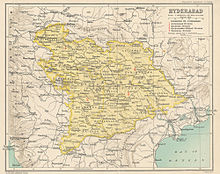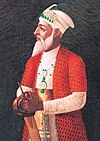Nizam of Hyderabad: Difference between revisions
No edit summary |
No edit summary |
||
| Line 9: | Line 9: | ||
|common_name = Hyderabad |
|common_name = Hyderabad |
||
|title_leader = [[Nizam]] |
|title_leader = [[Nizam]] |
||
|image_flag = |
|image_flag = |
||
| caption = |
| caption = |
||
|image_map = Anglo-Mysore War 4.png |
|image_map = Anglo-Mysore War 4.png |
||
|image_map_caption = Nizam's dominions at its peak during the [[Fourth Anglo-Mysore War]] |
|image_map_caption = Nizam's dominions at its peak during the [[Fourth Anglo-Mysore War]] |
||
Revision as of 13:39, 1 January 2016
| Nizam of Hyderabad | |||||||||||
|---|---|---|---|---|---|---|---|---|---|---|---|
| Semi-autonomous domain of the Mughal Empire | |||||||||||
| 1720–1803 | |||||||||||
 Nizam's dominions at its peak during the Fourth Anglo-Mysore War | |||||||||||
| Capital | Aurangabad (from 1724) to Hyderabad (1763 till 1803) | ||||||||||
| Government | |||||||||||
| Nizam | |||||||||||
• 1720–48 | Asaf Jah I (first) | ||||||||||
• 1734–1803 | Asaf Jah II (last) | ||||||||||
| History | |||||||||||
• Established | 1720 | ||||||||||
• Disestablished | 1803 | ||||||||||
| |||||||||||
| Today part of | India: Telangana Maharashtra Karnataka | ||||||||||
The Nizam-ul-Mulk of Hyderabad, popularly known as the Nizam of Hyderabad, was a monarch of the Hyderabad State, now divided into Telangana state, Hyderabad-Karnataka region of Karnataka and Marathwada region of Maharashtra. Nizam, shortened from Nizam-ul-Mulk, meaning Administrator of the Realm, was the title of the sovereigns of Hyderabad State was the premier Prince of India, since 1724, belonging to the Asaf Jah dynasty.
The Asaf Jah dynasty was of Turkic origin from the region around Samarkand in modern-day Uzbekistan, The dynasty was founded by Mir Qamar-ud-Din Siddiqi, a viceroy of the Deccan under the Mughal Empire from 1713 to 1721. He intermittently ruled after Aurangzeb's death in 1707. In 1724, Mughal control lapsed, and Asaf Jah declared himself independent in Hyderabad.
Following the decline of the Mughal power, India saw the rise of Maratha Empire. The Nizam himself saw many invasions by the Marathas, which resulted in the Nizam paying a regular tax (Chauth) to the Marathas. The major battles fought between the Marathas and the Nizam include Palkhed, Udgir, Rakshasbhuvan, and Kharda, in all of which the Nizam lost.[1][2]
In 1903 the Berar region of the state was separated and merged into the Central Provinces of British India, to form the Central Provinces and Berar.
In 1947, at the time of the partition of India, Britain offered the 566 princely states in the sub-continent the option of acceding to either India or Pakistan, or remaining independent.
Hyderabad was the largest and most prosperous of all princely states in India. It covered 82,698 square miles (214,190 km2) of fairly homogeneous territory and had a population of roughly 16.34 million people (as per the 1941 census), of which a majority (85%) was Hindu. Hyderabad State had its own army, airline, telecommunication system, railway network, postal system, currency and radio broadcasting service. In spite of the overwhelming Hindu majority, Hindus were severely under-represented in government, police and the military. Of 1765 officers in the State Army, 1268 were Muslims, 421 were Hindus, and 121 others were Christians, Parsis and Sikhs. Of the officials drawing a salary between Rs.600-1200 per month, 59 were Muslims, 5 were Hindus and 38 were of other religions. The Nizam and his nobles, who were mostly Muslims, owned 40% of the total land in the state
Seven Nizams ruled Hyderabad for two centuries until 1947. The Asaf Jahi rulers were great patrons of literature, art, architecture, and culture, and rich food. The Nizams patronized foreign Persian art, Persian architecture and Persian culture, which became central to the Hyderabadi Muslim identity. The last Nizam had been the richest man in the world in his time.[3] The Nizams also developed the railway, and the introduction of electricity; developed roads, airways, irrigation and reservoirs; in fact, all major public buildings in Hyderabad City were built during his reign under the British Raj. He pushed education, science, and establishment of Osmania University.

Family origins

The Asaf was a dynasty of Turkic origin from the region around Samarkand in modern-day Uzbekistan. They came to India in the late 17th century, and became servants of the Mughal Empire. As the Mughals were great patrons of Persian culture, language, literature: the family found a ready patronage.
Origin of the title
Nizām-ul-mulk was a title first used in Urdu around 1600 to mean Governor of the realm or Deputy for the Whole Empire. The word is derived from the Arabic language, as in (Abu Ali Hasan ibn Ali Tusi (April 10, 1018 – October 14, 1092), better known by his honorific title of Nizam al-Mulk (Arabic: نظامالملک, "Order of the Realm"), Nizām (نظام), meaning order, arrangement. The Nizam was referred to as Ala Hadrat / Ala Hazrat or Nizam Sarkar, meaning His Exalted Highness.
Rise of the Nizams
The first Nizam ruled on behalf of the Mughal emperors. After the death of Aurangzeb, the Nizams split from the Mughals to form an independent kingdom. When the British achieved paramountcy over India, the Nizams were allowed to continue to rule their princely states as client kings. The Nizams retained internal power over Hyderabad State until 17 September 1948 when Hyderabad was integrated into the new Indian Union.
The Asaf Jah dynasty had only seven rulers; however there was a period of 13 years after the rule of the first Nizam when three of his sons (Nasir Jung, Muzafar Jung and Salabath Jung) ruled. They were not officially recognised as the rulers.
A legend about the first Nizam[vague] states that, on one of his hunting trips he was offered some kulcha oval bread (an Indian bread) by a holy man and was asked to eat as many as he could. The Nizam could eat seven kulchas and the holy man then prophesied that seven generations of his family would rule the state.
By tradition no Nizam has ever left India no matter how good a reason might exist for doing so, as it was said[by whom?], "the Sovereign is too precious to his people ever to leave India.". After the Nizam family, the next group in the hierarchy was the Paigah family. The royal family had matrimonial relations only with them and were the closest group of nobles during the Nizam's period.
Nizam of Hyderabad (1724–1948)
| Image | Titular Name | Personal Name | Date of birth | Nizam From | Nizam Until | Date of death |
|---|---|---|---|---|---|---|
 |
Nizam-ul-Mulk, Asaf Jah I نظامالملک آصف جاہ |
Mir Qamar-ud-din Khan | 20 August 1671 | 31 July 1724 | 1 June 1748 | |
 |
Nasir Jung نصیرجنگ |
Mir Ahmed Ali Khan | 26 February 1712 | 1 June 1748 | 16 December 1750 | |
 |
Muzaffar Jung مظفرجنگ |
Mir Hidayat Muhi-ud-din Sa'adullah Khan | ? | 16 December 1750 | 13 February 1751 | |
 |
Salabat Jung صلابت جنگ |
Mir Sa'id Muhammad Khan | 24 November 1718 | 13 February 1751 | 8 July 1762 (deposed) |
16 September 1763 |
 |
Nizam-ul-Mulk, Asaf Jah II نظامالملک آصف جاہ دوم |
Mir Nizam Ali Khan | 7 March 1734 | 8 July 1762 | 6 August 1803 | |
See also
- Sultanat-e-Khudad of Mysore
- Hyderabad State
- Hyderabadi Muslims
- History of Telangana
- Carnatic Wars
- History of Hyderabad, India
- Paigah
- Salar Jung family
- List of Sunni Muslim dynasties
References
- ^ "Dictionary of Battles and Sieges: P-Z". google.com.pk.
- ^ "The State at War in South Asia". google.com.pk.
- ^ "Top 10: Richest Men (of All Time)". inStash. Retrieved 28 September 2014.
- Zubrzycki, John (2006). The Last Nizam: An Indian Prince in the Australian Outback. Australia: Pan Macmillan. ISBN 978-0-330-42321-2.
- Regani, Sarojini (1988) [First published 1963]. Nizam-British Relations, 1724–1857. New Delhi: Concept Publishing Company. ISBN 978-81-7022-195-1.
- Hastings, Fraser (1865). Our Faithful Ally, the Nizam. London: Smith, Elder & Co.
- Briggs, Henry George (1861). The Nizam: His History and Relations With the British Government, Volume 1. London: B. Quaritch.
- Lynton, Harriet Ronken; Rajan, Mohini (1974). The Days of the Beloved. University of California Press. ISBN 0-520-02442-7.
- University of Queensland feature
Further reading
- Mughal Administration of Deccan Under Nizamul Mulk Asaf Jah, 1720–48 A.D.By M. A. Nayeem, Indian Council of Historical Research, University of Pune, Dept. of History [1]
"The Days of the Beloved" Harriet Ronken Lynton and Mohini Rajan, Berkeley University Press
